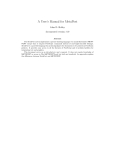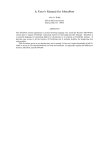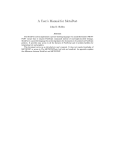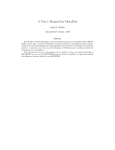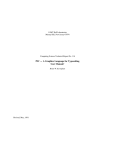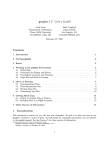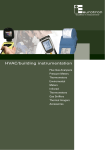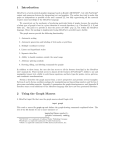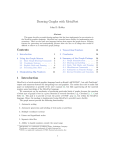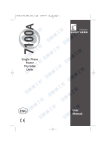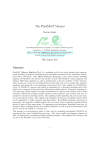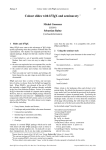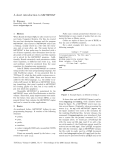Download Introduction to MetaPost
Transcript
Bijlage S Introduction to MetaPost 89 Introduction to MetaPost John D. Hobby AT&T Bell Laboratories 600 Mountain Ave. Murray Hill, New Jersey 07974 [email protected] Abstract MetaPost is a picture-drawing language very much like MET A F O N T except with PostScript output. The language provides access to all major features of Level 1 PostScript and it has facilities for integrating graphics with typeset text. This paper gives a brief overview of the MetaPost language and how it can be used. A few of the more interesting features are described in detail. Keywords: Metapost, graphics languages, F O N T , PostScript MET A 1 Introduction Although MET A F O N T was originally designed as a font-making tool, many people have recognized that it is also a powerful graphics language. The problem is that MET A F O N T ’s output is in the form of bitmap images instead of graphics primitives. A diagram can sometimes be created in MET A F O N T and typeset as a single huge character, but this is cumbersome and makes it difficult to deal with textual labels. A good examples of work along these lines appears in [4] and [8]. Another approach is to modify the MET A F O N T interpreter so that it outputs PostScript. Previous work along these lines presented in [1] and [10] has concentrated on producing PostScript fonts rather than graphics. Unlike these earlier systems, the MetaPost system involves the creation of a new language similar to MET A F O N T , but specifically designed for producing PostScript graphics. Preliminary comments on MetaPost appeared in [2]. Since MetaPost is based on the public-domain MET A F O N T source code given in [6], MetaPost has been able to inherit all the features of MET A F O N T that make it a powerful graphics language: The ability to store and manipulate coordinate pairs, straight and curved paths, coordinate transformations, pen shapes, and complete pictures. A Flexible and powerful mechanisms for constructing smooth curves and straight lines. The ability to draw straight and curved lines of any thickness and to fill a region given its boundary. Mechanisms for solving linear equations so that geometric information can be specified in a largely declarative manner. A powerful macro facility that allows the language to be extended syntactically and semantically. Operators for intersecting curves, finding tangent lines, finding points on a curve that match a given tangent direction, and extracting subpaths. In addition to these features, MetaPost allows pictures to contain text, dashed lines, clipping paths, and areas filled with gray or other colors. There are also data types for colors and recipes for dashed lines. In addition, there are important facilities for generating and manipulating typeset text. Readers familiar with other graphics languages such as Kernighan’s Pic [5] and Wichura’s PicTEX [9] will see that MetaPost is considerably more powerful. Section 2 gives a general idea of what the language is like and what can be done with it. More detailed discussions of interesting features follow in Section 3. This includes Section 3.1 on integrating text and graphics, Section 3.2 on dealing with dashed lines, and Section 3.3 on drawing arrows. Finally, Section 4 deals with macro packages and Section 5 presents some concluding remarks. 2 Overview of the Language MetaPost is a batch-oriented graphics language that achieves great power and flexibility by giving up some the ease of use found in interactive graphics editors such as MacDraw. A MetaPost user prepares an input file such as the one shown in Figure 1. Invoking the MetaPost interpreter produces an encapsulated PostScript output file that can be included in a TEX doc- Presented at EuroT X ’92, September 14–18, Prague, Czechoslovakia. E Dutch TEX Users Group (NTG), P.O. Box 394, 1740 AJ Schagen, The Netherlands Reprint MAPS#9 (92.2); Nov 1992 90 Introduction to MetaPost Bijlage S beginfig(1); draw (20,20)--(0,0)--(0,30)--(30,0)--(0,0); endfig; end Figuur 1: A MetaPost input file and the resulting output 2 3 2 3 4 4 1 0 1 0 (a) (b) Figuur 2: A sequence of points and a curve formed by connecting them. 2 3 4 1 0 (a) (b) (c) Figuur 3: A closed curve and some effects that can be achieved by rescaling it. ument or viewed with a PostScript interpreter such as GhostScript. The input file in the figure has a single beginfig: : : endfig block. There could be more such blocks, in which case each would produce a separate output file Since this paper is not intended to be a user’s manual, no attempt will be made to show the exact syntax used to create subsequent examples. Instead, we concentrate on general concepts with the aim of showing what MetaPost can do. The interested reader can refer to [3] for details. Another thing MetaPost can do is draw curved lines. If points P0, P1 , : : : , P4 are as in Figure 2a, asking the interpreter to connect them in order produces the curve in Figure 2b. Asking for a smooth closed curve through the same sequence of points produces Figure 3a. Since MetaPost has data types and operators for objects like curved lines, it is possible to store the curve in a path variable p and use a statement like to draw rescaled versions of p. Figure 3b was generated by placing this statement in a loop that scans various values of s. There is also a fill statement that fills the interior of a closed curve with a color or a shade of gray. The filled regions in Figure 3c illustrate how overlapping fills overwrite each other. The figure was generated by filling the outermost curve with light gray, then filling the next smaller curve with white, then the next smaller curve with dark gray, etc. The examples given so far suggest that MetaPost allows drawing and filling, it has data types for numbers, coordinate pairs, and curved paths, it has operators for doing things like rescaling paths, and it has programming-language constructions such as loops. It also inherits from MET A F O N T the ability to solve linear equations and deal with a broad class of coordinate transformations. Figure 4 illustrates linear equations and coordinate transformations. It was generated by introducing an unknown transformation T, giving a pair of equations draw p scaled s Reprint MAPS#9 (92.2); Nov 1992 Dutch TEX Users Group (NTG), P.O. Box 394, 1740 AJ Schagen, The Netherlands Bijlage S Introduction to MetaPost 91 2 3 1 4 Figuur 4: An example of repeated transformations. b a (0,0) Figuur 5: A labeled diagram. that declare it to be shape-preserving, and declaring that it maps Point 1 into Point 2 and Point 3 into Point 4. The figure was created by generating a simple picture P and repeatedly drawing P and transforming it by T. gets typeset in a default font as determined by the string variable defaultfont. The initial value of defaultfont is likely to be "cmr10", but it can be changed to a different font name by giving an assignment such as 3 Interesting Features Anyone familiar with MET A F O N T can see that Section 2 did not begin to cover all the language features mentioned in the introduction. While it is impractical to give a detailed treatment of the entire language, we can concentrate on a few of the features that distinguish MetaPost from MET A F O N T and from other graphics languages. 3.1 Text in Pictures MetaPost has a number of features for including labels and other text in the figures it generates. The simplest way to do this is to use the label statement to specify the label text and the point to be labeled. If you are labeling some feature of a diagram you probably want to offset the label slightly to avoid overlapping. This is illustrated in Figure 5 where statements of the form label.top("a", hexpression1 i); label.lft("b", hexpression2 i); put the "a" label above the midpoint of the line it refers to and the "b" label is to the left of the midpoint of its line. (In addition to top and lft, there are six other optional suffixes for other label positions.) There is also a dotlabel command that marks a point with a dot and positions text as the label command does. For instance, the command defaultfont:="Times-Roman" When you change defaultfont, the new font name should be something that TEX would understand since MetaPost gets height and width information by reading the tfm file. (See [7]). It should be possible to use built-in PostScript fonts, but the names for them are system-dependent. Some systems may use rptmr or ps-times-roman instead of Times-Roman. A TEX font such as cmr10 is a little dangerous because it does not have a space character or certain ASCII symbols. In addition, MetaPost does not use the ligatures and kerning information that comes with a TEX font. The MetaPost language does not need elaborate typesetting abilities because there is a preprocessor that extracts TEX commands, runs them through TEX (or LaTEX), and translates the output into a form that the interpreter understands. There is even a separate preprocessor that handles troff commands. Any time you say btex htypesetting commandsi etex in a MetaPost input file, the preprocessor translates the htypesetting commandsi into a MetaPost picture expression that can be used in a label or dotlabel statement. For instance, a statement of the form label.lrt(btex $\sqrt x$ etex, hcoordinatesi) dotlabel.bot("(0,0)", (0,0)) was used to placed the label p x in Figure 6. generates a dot marked “(0,0)” as in Figure 5. For labeling statements such as label and dotlabel that use a string expression for the label text, the string Dutch TEX Users Group (NTG), P.O. Box 394, 1740 AJ Schagen, The Netherlands Reprint MAPS#9 (92.2); Nov 1992 92 Introduction to MetaPost Bijlage S p x y x Figuur 6: A figure with labels done in TEX. = 2 1 + cos x y axis y x axis Figuur 7: An example of how typeset labels can be rotated beginfig(1); .. . label(btex hTEX material using mymac.texi etex; hcoordinatesi); .. . Figure 7 illustrates some of the more complicated things that can be done with labels. Since the result of btex : : : etex is a picture, it can be operated on like a picture. In particular, it is possible to rotate the picture by giving btex $y$ axis etex rotated 90 as the argument to a label statement. Here is how TEX material gets translated into a form MetaPost understands: The MetaPost processor skips over btex : : : etex blocks and depends on a preprocessor to translate them into low level MetaPost commands. If the main file is fig.mp, the translated TEX material is placed in a file named fig.mpx. This is normally done silently without any user intervention but it could fail if one of the btex : : : etex blocks contains an erroneous TEX command. Then the erroneous TEX input is saved in the file mpxerr.tex and the error messages appear in mpxerr.log. TEX macro definitions or any other auxiliary TEX commands can be enclosed in a verbatimtex : : : etex block. The difference between btex and verbatimtex is that the former generates a picture expression while the latter only adds material for TEX to process. For instance, if you want TEX to typeset labels using macros defined in mymac.tex, your MetaPost input file would look something like this: verbatimtex input mymac etex n Reprint MAPS#9 (92.2); Nov 1992 MetaPost has an internal variable called prologues that controls the handling of text in pictures. Giving this internal variable a positive value causes causes output to be formatted as “structured PostScript” generated on the assumption that text comes from built-in PostScript fonts. This makes MetaPost output much more portable, but it generally does not work with TEX fonts unless you have them in PostScript Type 1 format. Many dvi-to-PostScript programs download bitmaps for only those characters actually used in the document. Such programs can handle MetaPost output if they understand the nonstandard PostScript comments that the MetaPost interpeter uses to indicate which characters need to be downloaded. Recent versions of Rokicki’s dvips have this capability. 3.2 Dashed Lines The MetaPost language provides many ways of changing the appearance of a line besides just changing its width. This is done by specifying a dash pattern when drawing a straight or curved line. Figure 8 shows a few examples of dash patterns and the lines they Dutch TEX Users Group (NTG), P.O. Box 394, 1740 AJ Schagen, The Netherlands Bijlage S Introduction to MetaPost 93 withdots scaled 2 withdots evenly scaled 4 evenly scaled 2 evenly Figuur 8: Dashed lines each labeled with the dash pattern used to create it. e4 shifted (18bp,0) e4 shifted (12bp,0) e4 shifted (6bp,0) e4 Figuur 9: Dashed lines each labeled with the corresponding dash pattern, where e4 refers to the dash pattern evenly scaled 4. 5 6 3 4 1 2 drawdblarrow z5..z6 drawarrow reverse(z3..z4) drawarrow z1..z2 Figuur 10: Three ways of drawing arrows. generate. There is a predefined dash pattern called evenly that makes dashes 3 points long separated by gaps of the same size. Another predefined dash pattern withdots produces dotted lines with dots 5 points apart. As shown in the figure, scaling the dash pattern produces dots further apart or longer dashes further apart. Another way to change a dash pattern is to alter its phase by shifting it horizontally. Shifting to the right makes the dashes move forward along the path and shifting to the left moves them backward. Figure 9 illustrates this effect. The dash pattern can be thought of as an infinitely repeating pattern strung out along a horizontal line where the portion of the line to the right of the y axis is laid out along the path to be dashed. When you shift a dash pattern so that the y axis crosses the middle of a dash, the first dash gets truncated. Thus the line with dash pattern e4 starts with a dash of length 12bp followed by a 12bp gap and another 12bp dash, etc., while e4 shifted (18bp,0) produces a 6bp dash, a 12 bp gap, then a 12bp dash, etc. This dash pattern could be specified more directly via the dashpattern function: dashpattern(on 6bp off 12bp on 6bp) This means “draw the first 6bp of the line, then skip the next 12bp, then draw another 6bp and repeat.” If the line to be dashed is more than 30bp long, the last 6bp of the first copy of the dash pattern will merge with the first 6bp of the next copy to form a dash 12bp long. 3.3 Arrows Drawing arrows like the ones in Figure 10 is simply a matter of saying drawarrow hpath expressioni instead of draw hpath expressioni. This draws the given path with an arrowhead at the end. If you want the arrowhead at the beginning of the path, there is an operator that reverses a path. For double-headed arrows, there is a drawdblarrow statement. The size of the arrowhead is guaranteed to be larger than the line width, but it might need adjusting if the line width is very large. This is done by assigning a new value to the internal variable ahlength that determines arrowhead length as shown in Figure 11. Increasing ahlength from the default value of 4 PostScript points to 1.5 centimeters produces the large arrowhead in Figure 11. There is also an ahangle parameter that controls the angle at the tip of the arrowhead. The default value of this angle is 45 degrees as shown in the figure. The arrowhead is created by filling the triangular region that is outlined in white in Figure 11 and then drawing the boundary with the current line width. Readers familiar with MET A F O N T will recognize this as the filldraw statement. 4 Macro Packages This section describes auxiliary macros not included in Plain MetaPost. The macros described in Section 4.1 Dutch TEX Users Group (NTG), P.O. Box 394, 1740 AJ Schagen, The Netherlands Reprint MAPS#9 (92.2); Nov 1992 94 Introduction to MetaPost ahlength Bijlage S ahangle ahlength Figuur 11: A large arrowhead with key parameters labeled and paths used to draw it marked with white lines. n nw w ne dy dx c dx dy sw e se s Figuur 12: The relationship between the picture given to boxit and the associated variables. The picture is indicated by a gray rectangle. Box Box b a Figuur 13: A “well-targeted arrow” generated by trimming the dashed sections from a curved path. make it convenient to do things that pic is good at [5]. Section 4.2 makes some brief remarks about other macro packages. In order to use a macro package, it is necessary to give a MetaPost command that names the macro file and asks the interpreter to read it. 4.1 Macros for Boxes The box-making macros are contained in a macro file called boxes.mp. This file can be accessed by giving the MetaPost command input boxes before any figures that use the box making macros. The basic tool for making boxes is the command boxit:hbox namei(hpicture expressioni) This creates variables hbox namei.c, hbox namei.n, hbox namei.e, : : : that can then be used for positioning the picture before drawing it. The actual drawing is done by a separate command drawboxed that takes a list of box names. If the command is boxit.bb(hpicturei), the box name is bb and the contents of the box is the hpicturei. In this case, bb.c the position where the center Reprint MAPS#9 (92.2); Nov 1992 of the picture is to be placed, and bb.sw, bb.se, bb.ne, and bb.nw are the corners of a rectangular path that will surround the picture. Variables bb.dx and bb.dy give the spacing between the picture and the surrounding rectangle, and bb.off is the amount by which the picture has to be shifted to achieve all this. When the boxit macro is called with box name b, it gives linear equations that force b.sw, b.se, b.ne, and b.nw to be the corners of a rectangle aligned on the x and y axes with the box contents centered inside as indicated by the gray rectangle in Figure 12. The values of b.dx, b.dy, and b.c are left unspecified so that the user can give equations for positioning the boxes. If no such equations are given, macros such as drawboxed can detect this and give default values. The default values for dx and dy variables are controlled by the internal variables defaultdx and defaultdy. If b represents a box name, drawboxed(b) draws the rectangular boundary of box b and then the contents of the box. This bounding rectangle can be accessed Dutch TEX Users Group (NTG), P.O. Box 394, 1740 AJ Schagen, The Netherlands Bijlage S Introduction to MetaPost ndtable: ni di +1 ni +1 di 95 nk dk hashtab: . . . ndblock Figuur 14: An example of what can be done with the boxes.mp macros n dy w dx c dx e dy s Figuur 15: The relationship between the picture given to circleit and the associated variables. The picture is indicated by a gray rectangle. b C b b b a Start B a (ajb) a b D (ajb) ab b Stop a a a Figuur 16: Circular and oval boxes generated using the boxes.mp macros. separately as bpath b, or in general bpath hbox namei One interesting use of the bounding rectangle is for generating “well-targeted arrows” as shown in Figure 13. Given a path from the center of Box a to the center of Box b, there are MetaPost operators that make it convenient to chop off the parts of the path before the first intersection with bpath a and after the last intersection with bpath b. There is also a special command boxjoin(hequation texti) that controls the relative position of consecutive boxes. Within the hequation texti, a and b represent the box names given in consecutive calls to boxit and the hequation texti gives equations to control the relative sizes and positions of the boxes. For example, the MetaPost code for Figure 14 uses boxjoin(a.se=b.sw; a.ne=b.nw) to causes boxes to line up horizontally. (It is instructive to compare this figure with the similar one in the pic manual [5]). The boxes.mp macros also provide for circular and oval boxes. These are a lot like rectangular boxes except for the shape of the bounding path. Such boxes Dutch TEX Users Group (NTG), P.O. Box 394, 1740 AJ Schagen, The Netherlands Reprint MAPS#9 (92.2); Nov 1992 96 Introduction to MetaPost are set up by the circleit macro: circleithbox namei(hpicture expressioni) The circleit macro defines pair variable just as boxit does, except that there are no corner points hbox namei.ne, hbox namei.sw, etc. A call to circleit.a( : : : ) gives relationships among points a.c, a.s, a.e, a.n, a.w and distances a.dx and a.dy. Together with a.c and a.off, these variables describe how the picture is centered in an oval as can be seen from the Figure 15. The drawboxed and bpath macros work for circleit boxes just as they do for boxit boxes. By default, the boundary path for a circleit box is a circle large enough to surround the box contents with a small safety margin controlled by the internal variable circmargin. Figure 16 gives an example. The oval boundary paths around “Start” and “Stop” in the figure are due to equations of the form box namei:dx = hbox namei:dy h that force those boxes to be noncircular. 4.2 Other Packages Why aren’t the boxes.mp macros automatically preloaded like the plain macros? One reason is that they are too specialized to really be treated as part of the core language. Another reason is that boxes.mp was intended to be the first of several macro packages, each one extending the language to cover another specialized application. In fact, there already is another macro package called rboxes.mp. This package builds on boxes.mp by providing another box shape: a rectangular box with rounded corners. Other box shapes could also be provided if there were a demand for them. There should also be a macro package for drawing graphs. No such package has been designed yet, but there have been promising preliminary experiments with the automatic generation of axis labels for uniform and logarithmic spacing. 5 Conclusion Building on MET A F O N T has made MetaPost a very powerful and flexible graphics language. It is espe- Reprint MAPS#9 (92.2); Nov 1992 Bijlage S cially well suited to generating figures in technical documents which may involve mathematical constraints that are best expressed symbolically. Such figures lack the aesthetic requirements that make font design so challenging. This paper has introduced the MetaPost language via examples concentrating on interesting features that distinguish the language from other graphics languages and from MET A F O N T . Readers who want to use the language should refer to [3]. The MetaPost interpreter is currently available to academic institutions under non-disclosure agreement. References [1] Leslie Carr. Of MET A F O N T and PostScript. In TEX User’s Group Eighth Annual Meeting Conference Proceedings. TEX User’s Group, Providence, Rhode Island, 1988. [2] John D. Hobby. A MET A F O N T -like system with PostScript output. Tugboat, the TEX User’s Group Newsletter, 10(4):505–512, December 1989. [3] J. D. Hobby. A user’s manual for MetaPost. Computing Science Technical Report no. 162, AT&T Bell Laboratories, Murray Hill, New Jersey, April 1992. Can be obtained by mailing “send 162 from research/cstr” to [email protected]. [4] Alan Jeffrey. Labelled diagrams in MET A F O N T . TUGboat, Communications of the TEX User’s Group, 12(2):227–229, June 1991. [5] Brian W. Kernighan. Pic—a graphics language for typesetting. In Unix Research System Papers, Tenth Edition, pages 53–77. AT&T Bell Laboratories, 1990. [6] D. E. Knuth. MET A F O N T the Program. Addison Wesley, Reading, Massachusetts, 1986. Volume D of Computers and Typesetting. [7] D. E. Knuth. The TEXbook. Addison Wesley, Reading, Massachusetts, 1986. Volume A of Computers and Typesetting. [8] Richard O. Simpson. Nontraditional uses of MET A F O N T . In Malcom Clark, editor, TEX Applications, Uses, Methods, pages 259–271. Ellis Horwood, 1990. [9] Michael J. Wichura. The PiCTEX Manual. TEX User’s Group, Providence, Rhode Island, 1987. [10] Shimon Yanai and Daniel M. Berry. Environment for translating MET A F O N T to PostScript. TUGboat, Communications of the TEX User’s Group, 11(4):525–541, November 1990. Dutch TEX Users Group (NTG), P.O. Box 394, 1740 AJ Schagen, The Netherlands








